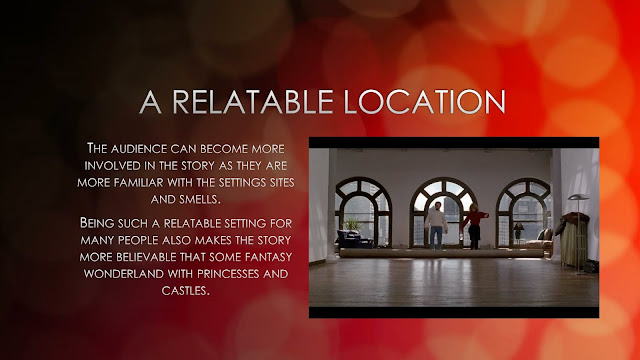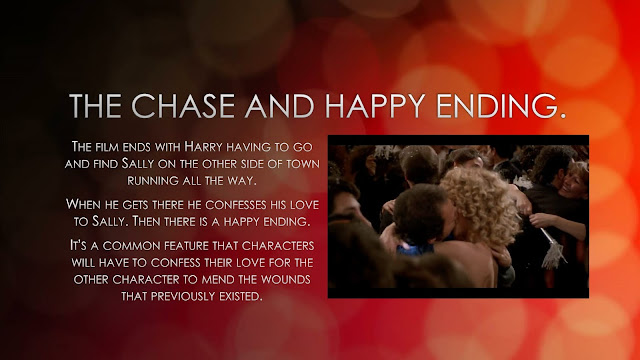BSA 104 (Scriptwrting) Week 6 : Genre Presentations and My Pitch
This week we had our genre breakdown and proposal
presentations, in this blog I will review each of the presentations and provide
an overview of what I learnt or noticed, at the end I will provide a summary of
my own short film pitch and what I hope for the future.
We were asked to provide a breakdown of our provided genres
and highlight the conventions used. Along with this we had to look at three
films in the given genre.
Below are some highlights from the day and things that I learned.
Below are some highlights from the day and things that I learned.
Presentation 1:
Genre: Film Noir
Group: Armand Le
Roux, Izaiah Painting and Darion Stewart
This is the one genre I hoped I wouldn't get, aside from
essentially being dead in the industry, it is one that I have had very little
exposure to and the exposure I have had has not been particularly enjoyable.
Having said that, it is an important genre to explore and all the movies this
group chose are ones that I still wish to see.
Movies:
–
The Killing
–
The Maltese Falcon
–
Chinatown
I hadn't seen any of these films, and still haven't, so I
don't have much to say about them, except that I want to see them more now than
I did before.
Presentation 2:
Genre: Heist
Group: Dillon Kirton, Jessica Jenkins and Sam Marrah
This is a genre that I always enjoy watching, but one that I
unfortunately haven't had a lot of experience with. There are a lot of classic
heist movies that sit waiting on my watch-list, because of this I wouldn't have
minded getting it as my genre. I also think it is an awesome genre for the
assessment we were given – even though we don't have to produce these, a main
requirement of our short scripts is that they have to be achievable with our
resources, budget and location. This seems like a fun idea when considering a
genre like heist movies – limiting a heist to a small location is a very
interesting idea. A dairy heist for example, is an instantly humorous concept.
Similar to my genre (romantic comedies) the conventions of heist movies come mostly in structure and the order of the events. A heist movie is easy to identify if it follows a certain number of tropes, these include:
Movies:
–
Die Hard
–
Ocean's 11
–
Inception
Presentation 3:
Genre: Horror
Group: Marcus Beirowski, Matthew Wilmshurst and Daniel
Chong
This is one of the two genres that I really wanted once the
five possibilities were first announced, there are two reasons for this – 1) I
enjoy the genre and I have much greater experience with it than with any of the
others and 2) it stands apart from the others as being much larger and varied.
All the other choices feel like sub-genres, horror is the
only one that is a full genre, and because of this, the choices for subject
matter become much larger. This is both an advantage and disadvantage for the
group who got horror, one one hand they can make any kind of horror movie they
want (creature feature, slasher, home invasion, supernatural, psychological –
the list goes on), which isn't nearly as limiting as the other genres, however
this also means that their work is cut out for them in terms of the
presentation. With so many different sub-genres there is a lot to study and the
conventions aren't so immediately apparent. I had a bit of trouble with my
sub-genre (Romantic-Comedy) when I chose Annie Hall as one of the three films,
a movie that includes none of the structural conventions of the genre, because
of this I had to change it and wasted precious time. With horror this is more
likely to happen.
The group were smart in their choices, looking at two
different sub-genres (supernatural and creature feature), which allows them
more possibilities for their own scripts. They pointed out how diverse the genre can but also looked at how conventions can change in a single film. One of these, which will be highlighted shortly, is the safe location trope - where the setting is usually something comfortable and void of danger. In Jaws this convention changes halfway throughout the film when the hero is placed in the most dangerous situation possible. This transition from the normal world to the supernatural is common in all types of horror - supernatural examples (the main other sub-genre they discussed) are Insidious (2010) and Poltergeist (1982), where the main character crosses over from the normal suburban neighborhood into the ghostly world. In a way the seemingly safe locations and obviously dangerous ones are both tropes of the genre, often used in the same movie to increase the stakes.
Some of the conventions they pointed out were:
–
Secluded locations
–
Religious imagery and exploration of the after
life
–
Vulnerable protagonists, or those who have
something of value that they can lose
–
A sense of mystery/an investigation
–
Unstoppable antagonist or something/someone
who's motive cannot be understood
–
Familiar or seemingly safe settings
The movies they looked at were:
–
The Sixth Sense
This is a supernatural horror, with a sense of mystery. It
explores the afterlife and supports a typical narrative convention of the genre
(specifically that ghosts are the souls of the deceased who have unfinished
business on earth and are unable to leave until they find closure), when it
came out it was extremely popular because of how it was told. The movie is
unconventional in the subject matter it focuses on, the young child who sees
the supernatural is usually a side character, who adds to the scare factor and
serves as someone to be protected or saved, here the story is centered on him.
The protagonist in this film changes about halfway through,
from the child psychologist to the kid himself, a very interesting technique
that is not common in horror movies, or films in general. Something very true
of horror movies is that not seeing the danger is usually scarier than seeing
it, because the audience's imagination will always conjure up something that is
much more horrifying than what can be shown on screen. The Sixth Sense
demonstrates this in the earlier scenes where the child psychologist is the
main character, but it also adheres to the vulnerable character convention,
which we see when the we start seeing things from the boy's perspective.
–
Jaws
This is a 'creature feature' or 'monster movie', but where the threat
is more real than supernatural. I think this is part of the reason it is so
well loved, it explores a monster that actually inhabits our planet, something
that you have the possibility of encountering in the real world. It has this
realistic quality but still stays true to a very important convention of the
genre – an unstoppable antagonist. These two truths about Jaws are also the two
things that made slasher movies so popular – something or someone real that
cannot be understood or bargained with.
–
The
Others
I haven't seen The Others, but I know that the twist at the end is very similar to that of The Sixth Sense. This is again a supernatural horror, and follows the classic twist structure where the audience believes one thing to be another the entire film, only for it to be revealed the other way around.
Presentation 4:
Genre: Disaster
Group: Kiarne Heidenrych, Matthew Butler and Asher Briggs
This is a genre that I wouldn't have minded to get – this was
because of the disaster films I've seen it seems like an easy one to break
down. It was also because like the Heist films I thought it would be
interesting to interpret into a smaller setting.
Movies:
–
The Day After Tomorrow
–
2012
–
World War Z
Presentation 5:
Genre: Romantic Comedy
Group: Simon Owen, Jean-Martin Fabre and Bootje Myburgh
Movies:
– 10 Things I Hate About You
– When Harry Met Sally
– Silver Linings Playbook
Our final Powerpoint Presentation Below
Our final Powerpoint Presentation Below
My Pitch:
A man is cursed in his youth to “die on the happiest day of
his life”, having succumbed to fear and superstition he goes out of his way to
make his own life an unpleasant experience. Things are complicated when he
falls in love.
Obeyed Conventions:
–
Best Friend Characters and Montage: These are
two elements of this genre that are very useful for efficient story-telling,
something that I will have to do for my 4-8 page script (although Patrick
assured me that the script can be longer if compelling enough). Montage is
efficient in spanning large periods of time or showing development, without
having to subject the audience to every second of that process.. The best
friend characters are a good way to show what the main characters are thinking
and to provide exposition without having to spend a lot of time communicating
these things, and without resorting to exposition. The montages in script form
will probably written like a Nolan script, where jumping back and forth between
locations while maintaining a single line of dialogue is common and works very
effectively.
–
Conflict and misunderstanding between leads:
These will be present because of the main characters predicament. It is common
for Rom Coms to show that the two romantic leads would be a compatible if it
were not for specific faults or situational factors.
–
Common Plot Points: I intend on incorporating
some key beats of a romantic comedy, albeit condensed. Because of the length I
won't have the ability to go through every one of the ten steps but some
important ones that I want present in the final product are: The Low Point, The
Chase, Deceleration of Love and Happy Ending.
Subverted Conventions:
–
Relatable/Realistic: The supernatural element
that is the key part of my concept makes it less relatable than the problems
represented in the majority of romantic comedies. In sense it's more similar
Silver Linings Playbook, where the lead suffered a mental condition not common
in most audience members. This isn't a big problem in that movie though,
because the audience can still on some level relate, the same can be said for
mine. The viewers will put themselves in my character's shoes, as is common in
'what if' scenarios.
–
Structure: While I intend on meeting some key
plot points, the structure will be different than the normal romantic comedy,
this is partly because that structure is very specific to an hour and a half to
hour and fifty minute film, and partly because of where in the story I want to
start. Like When Harry Met Sally and Silver Linings Playbook, my film will
focus more on certain aspects than others.
–
Multiple Protagonists: I will forego the use of
two protagonists and instead have just the male character as the one we follow,
akin to Silver Linings Playbook.





















It was a fantastic presentation. Please note that the modern reincarnation of FilmNoir is neo-noir... and there are plenty of examples of this. Don't forget Blade Runner as a great example of Film Noir!
ReplyDelete